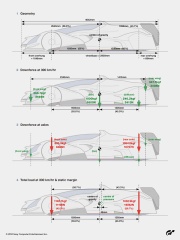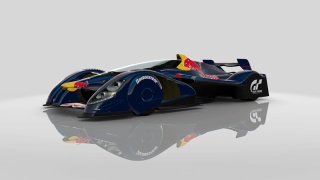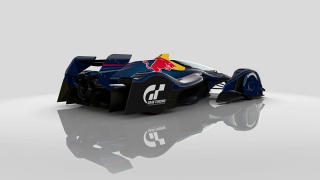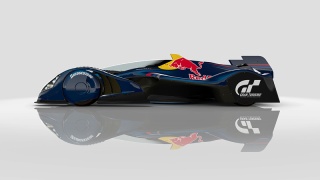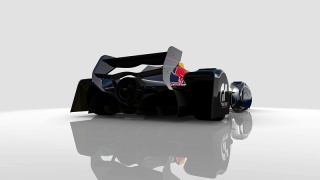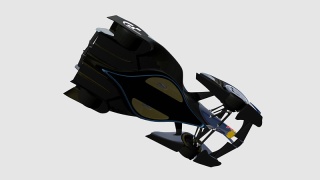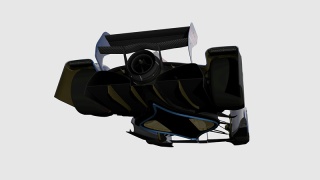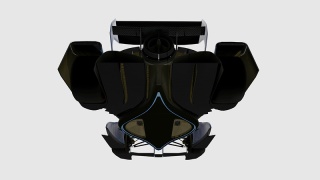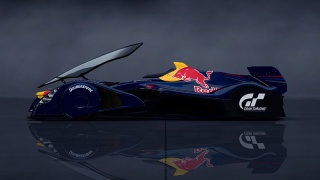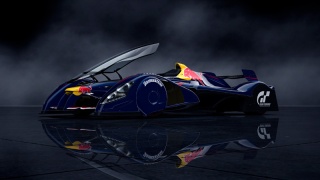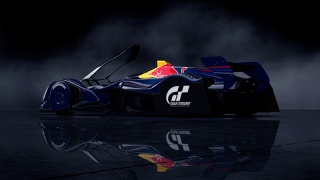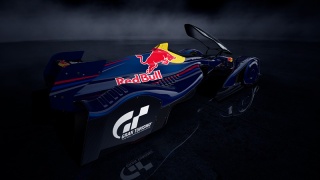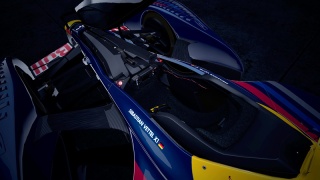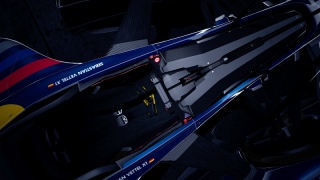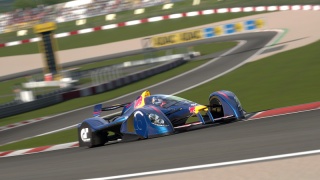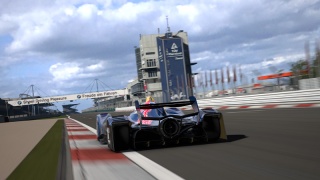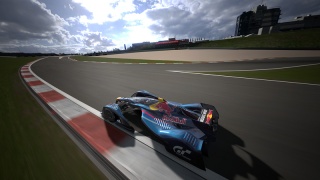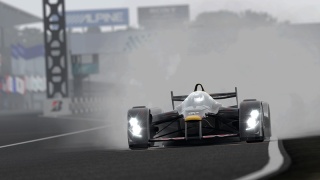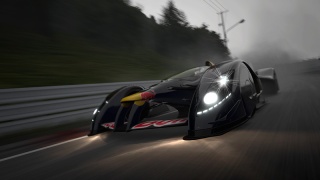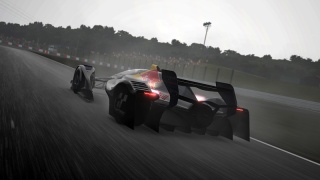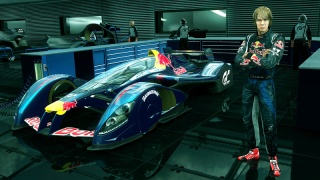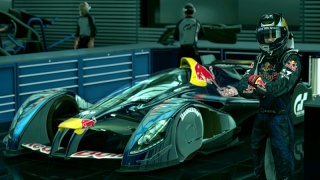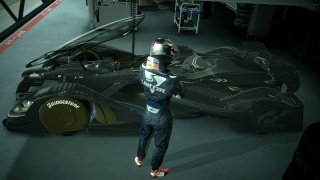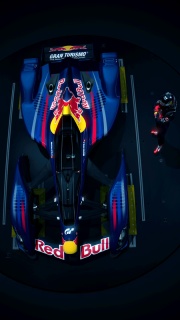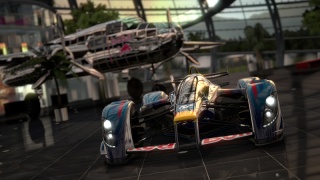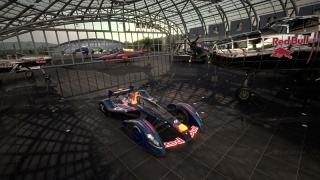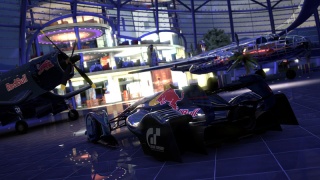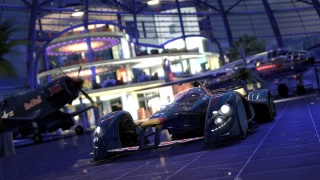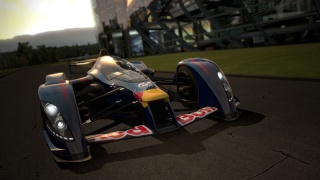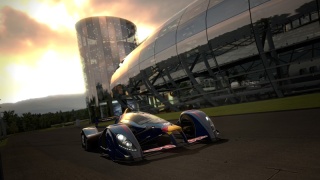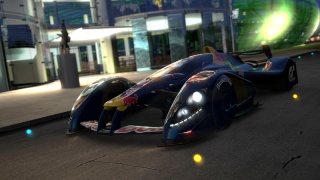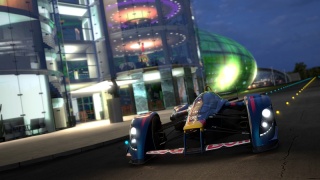Red Bull X2010 Prototype Full Reveal

- The "Red Bull X2010 S. Vettel" in Red Bull livery.

- Sebastian Vettel driving the Red Bull X2010 Prototype on the Nürburgring GP course.
All races that exist in today's world are restricted by regulations. However the Red Bull X2010 Prototype is a machine born from a fantastic "what if" dream of Polyphony; "What would the fastest racing car on Earth, free of any and all regulations look like?"
Initially the Red Bull X2010 Prototype was a single seater, canopied prototype wing car with covered front wheels. The performance brought about by the 1500ps direct injection V6 Twin Turbo would have been spectacular as is, with a top speed of 400km/h and a maximum lateral acceleration of 6G. But this concept showed an even greater advancement through the help of Red Bull Racing, who became a partner in this project.
Red Bull Racing's chief technical officer, the genius aerodynamicist Adrian Newey proposed that "Fan Car" technology, a dream that he had held to himself over the years be added to the Red Bull X2010 Prototype.
A "fan car" is a vehicle having a fan mechanism which forces the air out from underneath the car, to reduce air pressure under the car's floor. The resulting suction draws the car to the ground surface and creates a massive amount of downforce. And because it can create downforce regardless of the vehicle's current speed, it dramatically raises its cornering speed even in low speed corners.
The incredible ability of fan cars has already been proven in history. The Chaparral 2J fan car entered in the 1970 Can-Am series was so fast that it was banned after just 1 season. Even in the F1, the BT46B fan car entered in 1978 by Brabham dominated the opening round of the series with extreme speed, and was banned just after that single race.
With this proposal from Mr. Newey, the machine was transformed with a large fan added to the rear end of the body. With additional advice regarding the shapes of the front and rear wings and rear diffuser, its aerodynamics became even further refined. As a result, the Red Bull X2010 Prototype attained an astonishing level of performance, reaching a top speed of over 450km/h, with a maximum lateral acceleration reaching up to 8.75G. This is a performance level that is at the very limits of what a normal human body can withstand.
The driver who performed the shakedown test of the machine in Gran Turismo 5, was the world famous Sebastian Vettel. In his very first run on the Suzuka Circuit, he shortened the record time of the course by over 20 seconds. And in the test drive on the Nurburgring GP Course, he marked a record time of 1 minute 4 seconds, drawing out the incredible potential of the Red Bull X2010 Prototype.
This is the dream of the fastest racing car on land, brought to life through the collaboration between Polyphony and Red Bull. Witness for yourself the power of the Red Bull X2010 Prototype through the in-game "S. Vettel X Challenge", the first driving lesson ever in Gran Turismo to be performed by a top professional driver.
The results were thrilling. Red Bull X2010 Prototype is about evolution. Delivering the optimum combination of tested technologies in a single integrated design. This would be the future of racing were we not bound by regulations, but one that is achievable today. And as Sebastian has shown, it is about devastating speed coupled with real handling control. Today thanks to PlayStation®3 and Gran Turismo we can test drive the future.
Kazunori Yamauchi, President, Polyphony Digital Inc and creator of the Gran Turismo series
Red Bull X2010 Prototype sees the marriage of virtual and real worlds as we explore the boundaries of our technology and aesthetic senses. The Red Bull X2010 Prototype Project has been motivated by curiosity and passion, powerful forces that brought together the best the world has to offer in design, physics simulation, racing car product technology and driving.
X2010 Downforce Specifications
Lets try calculating the cornering G's of the Red Bull X2010 Prototype at 300km/h from the total tire load and coefficient of friction for the tires. |
| Red Bull X2010 Prototype Specifications | ||
|---|---|---|
| Dimensions |
|
|
| Weight |
| |
| Engine |
| |
| Suspension | Full Active Ride Suspension | |
| Downforce generated at the bottom due to the fan |
| |
| Downforce acting at vehicle speed squared due to the wings/Venturi Effect |
At 100km/h: 1044.7N, (106.6kgf) equal to 0.17G At 200km/h: 4181.7N, (426.7kgf) equal to 0.69G At 300km/h: 9412.9N, (960.5kgf) equal to 1.56G At 400km/h: 16732.5N, (1707.4kgf) equal to 2.78G | |
| Performance Data |
|
|
-
Announcing the 'Gran Turismo World Series' 2026 Live Events Locations and More! Online Qualifiers Start On 14 January!
We are pleased to announce more details about the 'Gran Turismo World Series' 20...
-
Announcing the 'Gran Turismo World Series' 2026! Four Live Events Starting with Abu Dhabi in March
We are pleased to announce the opening of the 'Gran Turismo World Series' 2026, ...
-
To all World Finals – Fukuoka ticket holders
Thank you for purchasing a ticket to the World Finals in Fukuoka.
-
Co-Streamers Wanted! All Hands on Deck for the World Finals in Fukuoka!
The 'World Finals', the finale of the 'Gran Turismo World Series' 2025, will be ...
-
Receive Two 'Series Champion Livery' Race Car Tickets With the 'Gran Turismo World Series' 2025 World Finals - Fukuoka 'Viewers Gift' Campaign!
The 'Gran Turismo World Series' 2025 World Finals will take place on Saturday, 2...
-
Receive up to 2,000,000 In-game Credits with the 'Gran Turismo World Series' 2025 World Finals – Fukuoka 'Predict the Series Champions' Campaign!
The 'Gran Turismo World Series' 2025 World Finals will take place on Saturday, 2...



